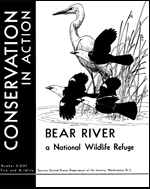US Fish & Wildlife Service
Date of this Version
10-5-2022
Citation
Ecological Applications. 2023;33:e2788. https://doi.org/10.1002/eap.2788
Abstract
Management of waterfowl that migrate seasonally across North America occurs within four flyways that were delineated in the early 1900s to include the annual movements of populations. Movements may have changed over the past century since the administrative flyways were established, and may do so while management plans are in use, so information about transitions among flyways through time can illustrate how management assumptions may change. Today there are more than 12 million records from 60 years of migratory waterfowl band recoveries to assess adaptive management approaches that will be most effective when they account for movements within and between flyways. We examined how much the movement of North American waterfowl occurs between flyways, whether those movements have changed through time, and whether movements of mallards are representative of multiple species, as suggested by current harvest management strategies. We estimated the probability a duck would transition from one flyway to another and the strength of migratory connectivity (MC) for each species within and among flyways. We used capture–mark–recovery models to estimate population-specific movement within and among flyways (transition probabilities) for 15 migratory waterfowl species that were banded during breeding and recovered during winter. We developed new functionality in the R package MigConnectivity to estimate the species-specific strength of MC using transition probability samples from the capture–mark–recovery models. We found the regular movement of duck populations among flyways, overall weak MC, and no consistent change in migratory movements through time. Mallard movements were median among all duck species, but significantly different from many species, particularly diving ducks. Despite the significant movement between flyways, our work suggests flyway management of waterfowl matches many of the seasonal movements of these species when considering mid-continent flyway management. We recommend models accounting for all transition probabilities between populations and regularly estimating harvest derivations, transition probabilities, and MC metrics to verify that the current movements match model assumptions.


Comments
U.S. Government employees and their work is in the public domain in the USA.